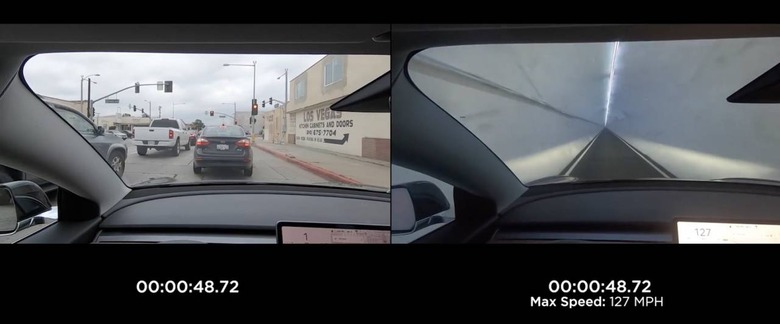Watch Elon Musk's Boring Company Race A Tunnel Tesla Against LA Traffic
Elon Musk's Boring Company has run a race between a regular car and one of its LA tunnels, with the Top Gear-style challenge showing the potential speed improvements when you bypass road congestion. The video sees two Tesla Model 3 cars go head-to-head, one on a traditional road route while the other descends into a tunnel and accelerates up to 127 mph.
The result, you won't be surprised to hear, is a conclusive win for the Boring Company tunnel. Indeed, by the time the Model 3 using the tunnel gets to its destination, the road-going Model 3 is only just getting through the first set of traffic lights.
Fast forward to 1 minute and 36 seconds later, and the tunnel car has made it to its destination. It takes more than three minutes more for the car reliant on surface roads to catch up. Similarly unsurprising – and probably for the best, given traffic laws – the latter doesn't get anywhere close to 127 mph.
Certainly, it's a good example of how tunnels can deliver a speedier commute than the traffic you'd find in LA. Compared to the original Boring Company demonstration, too, this is an easier process mechanically. Now that Tesla has switched to relying on Autopilot to keep the car centered in the tunnel, it can ditch the wheel guides that were fitted to earlier demo vehicles.
"This is simple and just works," Elon Musk said in explanation, when asked why Tesla and the Boring Company had abandoned an earlier plan to mount each car onto an electric sled to make each trip.
Few argue with the idea that going direct, through an empty tunnel, is going to be quicker than joining Los Angeles traffic. Nonetheless the concerns about the Boring Company's plans still remain, for the most part, unaddressed. Critics of the scheme have questioned the efficiency of individual cars running through the tunnels, in comparison to a bus or train which could fit far more people in each vehicle.

Safety questions also linger. What happens if a car breaks down, or if a collision somehow takes place, and how passengers and vehicles are retrieved is a frequent concern among even tunneling enthusiasts. The Boring Company's tunnels are relatively narrow, sized to fit an average car, whereas most road tunnels would be considerably larger.
At this point, though an entertaining video, this demo seems unlikely to convince skeptics or dissuade fans of the scheme. The Boring Company has, though, managed to win one new contract, with the board of the Las Vegas Visitors and Convention Authority approving a contract worth $48.6 million for a loop to be installed at the Las Vegas Convention Center. That is expected to include two tunnels for vehicles, along with three stations.
It's unclear at this stage whether the LVCC loop will be accessible for regular Tesla owners. The Boring Company says that it will be compatible both with regular "autonomous electric vehicles" (AEVs) like the Model X and Model 3, and so-called High-Occupancy AEVs, which use a modified Model X chassis to transport up to sixteen passengers with both sitting and standing room. That, though, may not mean regular Tesla drivers can access the loop in their own cars.
